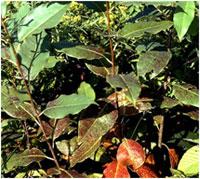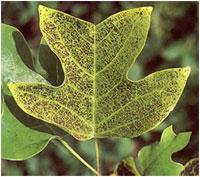Ecosystem Effects of Ozone Pollution
Ozone can affect sensitive vegetation and ecosystems, including forests, parks, wildlife refuges and wilderness areas. Ozone can especially cause damage during the growing season.
What plants are at risk?
Plant species that are sensitive to the effects of ozone on their growth include trees found in many areas of the U.S., such as: black cherry
black cherry
- black cherry
- quaking aspen
- tulip poplar
- white pine
- ponderosa pine
- red alder.
What does ozone exposure do to sensitive plants?
When sufficient ozone enters the leaves of a sensitive plant, it can:
- Reduce photosynthesis, which is the process that plants use to convert sunlight to energy to live and grow.
- Slow the plant's growth.
- Increase sensitive plants' risk of:
- disease
 tulip poplar
tulip poplar - damage from insects
- effects of other pollutants
- harm from severe weather.
- disease
Also, some plants can show visible marks on their leaves when ozone is present under certain conditions.
What happens to the ecosystem?
The effects of ozone on individual plants can then have negative impacts on ecosystems, including:
- loss of species diversity (less variety of plants, animals, insects, and fish)
- changes to the specific assortment of plants present in a forest
- changes to habitat quality
- changes to water and nutrient cycles.
